Usually, I carry at least three pairs of gloves in winter. No glove serves every purpose on a winter backpacking trip. For that reason, I select a combination of different gloves to meet different requirements.
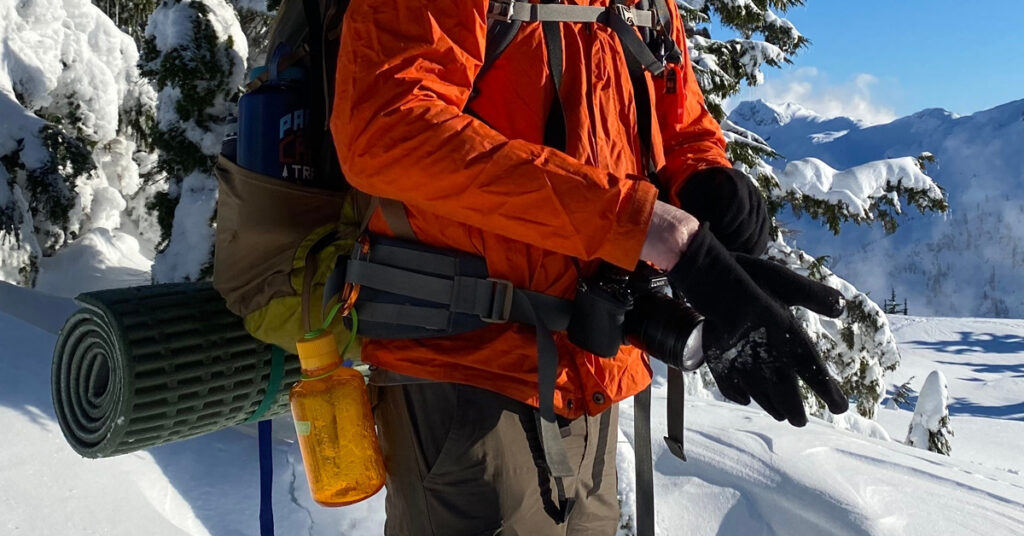
When I’m packing gloves for winter backpacking, I am concerned with three conditions—cold, wind, and moisture. I only want to carry what I will need, so I pack gloves depending on likely conditions, which here in the Cascades will be moderate cold (20–45ºF) or deep cold (0–20ºF). I also think about the likelihood of my gloves getting wet from rain, melting snow, or my hands exposed to high winds. Together, these factors determine which gloves I will be carrying. I am almost always carrying two to three pairs of gloves.
Liner gloves
(For hiking, camp, and sleeping)
I always bring fleece liner gloves. These are the gloves I wear while hiking—my trekking gloves. I sometimes wear them while sleeping. For those two reasons, I wear these gloves more than any others.
Gloves can get wet from sweat, rain, or from contact with the snow, so I often bring two pairs. Ideally, I hope to have one dry pair for activities at camp. I have found that circumstances rarely allow wet gloves to fully dry out on a short winter trip. Once gloves get wet they are useless and I rely on a backup pair. Even without contact with wet melting snow, it is helpful to change liner gloves once you stop hiking and start setting up your tent. Sweaty gloves, especially in windy conditions, will make your hands painfully cold.
In the shoulder seasons, the liner gloves also provide UV protection on large snow fields.
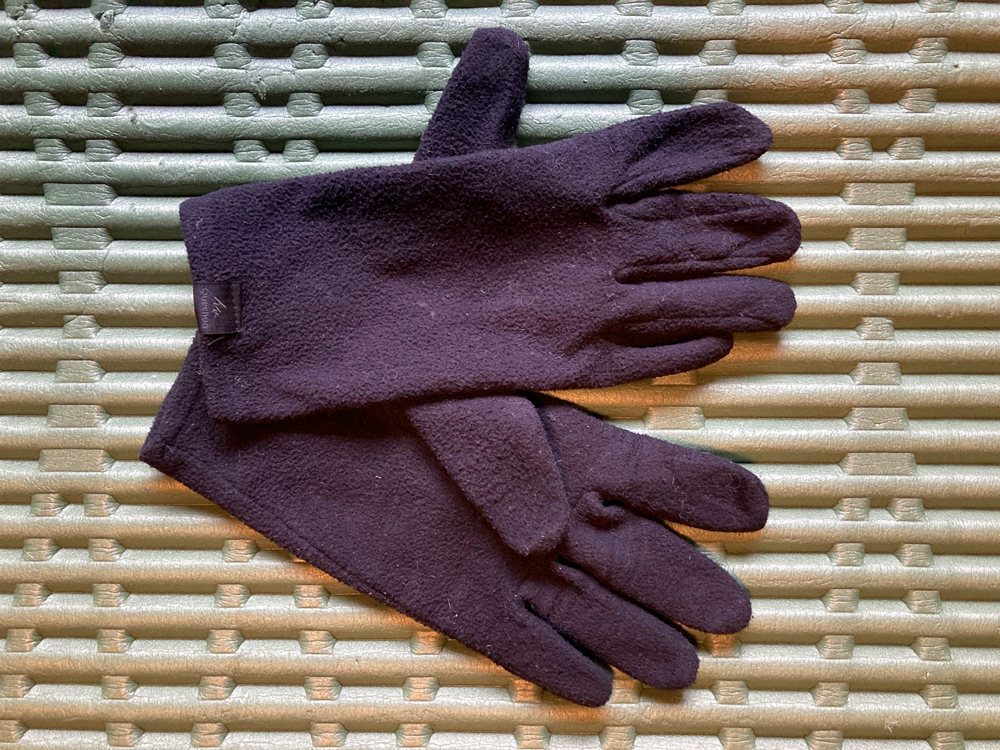
I started using REI liner gloves ($19.95), which are thin, lightweight, and comfortable for hiking. I have also used Smartwool Liner Tech gloves ($24.00). Both of these gloves tended to disintegrate over time when used with trekking poles. For this reason, I switched to Forclaz Trek 100 fleece hiking gloves, which weigh slightly less than an ounce (0.90 oz., $2.99–4.99, sold by French retailer Decathlon). The fleece gloves have proven to be more durable and less costly to replace.
Waterproof Thermal gloves or freezer gloves
(For hiking and camp, for wet or windy conditions)
Several backpackers have started using waterproof thermal gloves or what some might call “freezer work gloves.”
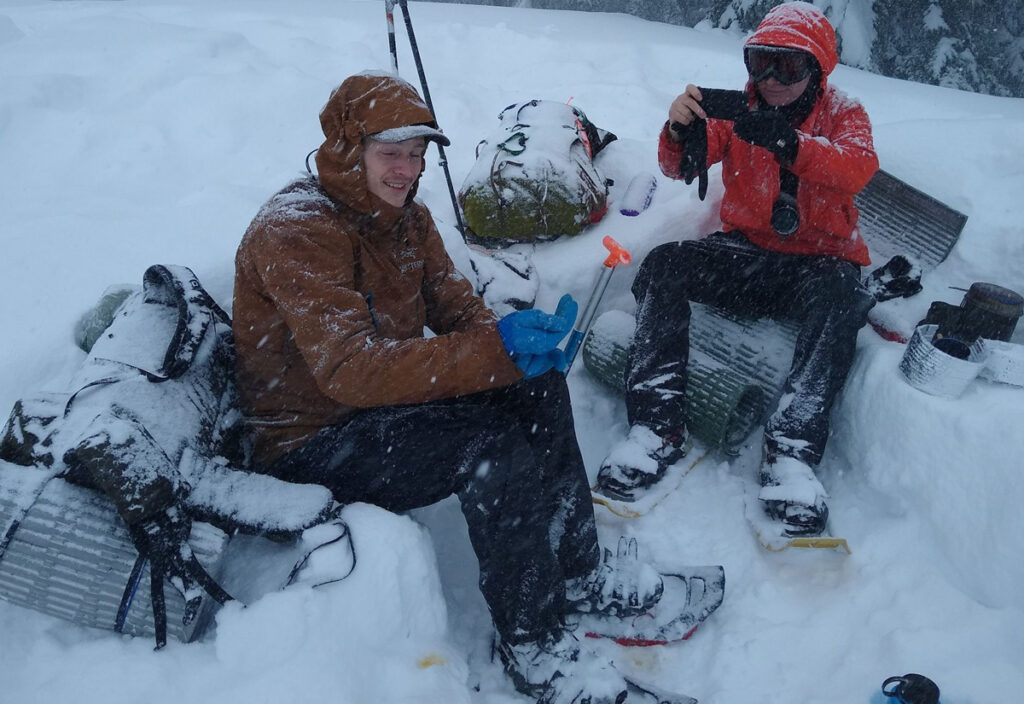
This type of glove has clear benefits. They are relatively light and much warmer than fleece liner gloves, adding extra comfort at the beginning of a hike in the early morning. They are a bit too warm for hiking in winter most of the time but sometimes just right, and excellent during camp setup. Most important, they provide much more wind protection than liner gloves and they are 100% waterproof. Finally, they are inexpensive (usually $10–12). They would also keep your hands warm and dry during an avalanche rescue.
I would not want to sleep wearing them because they are too warm and don’t breathe well.
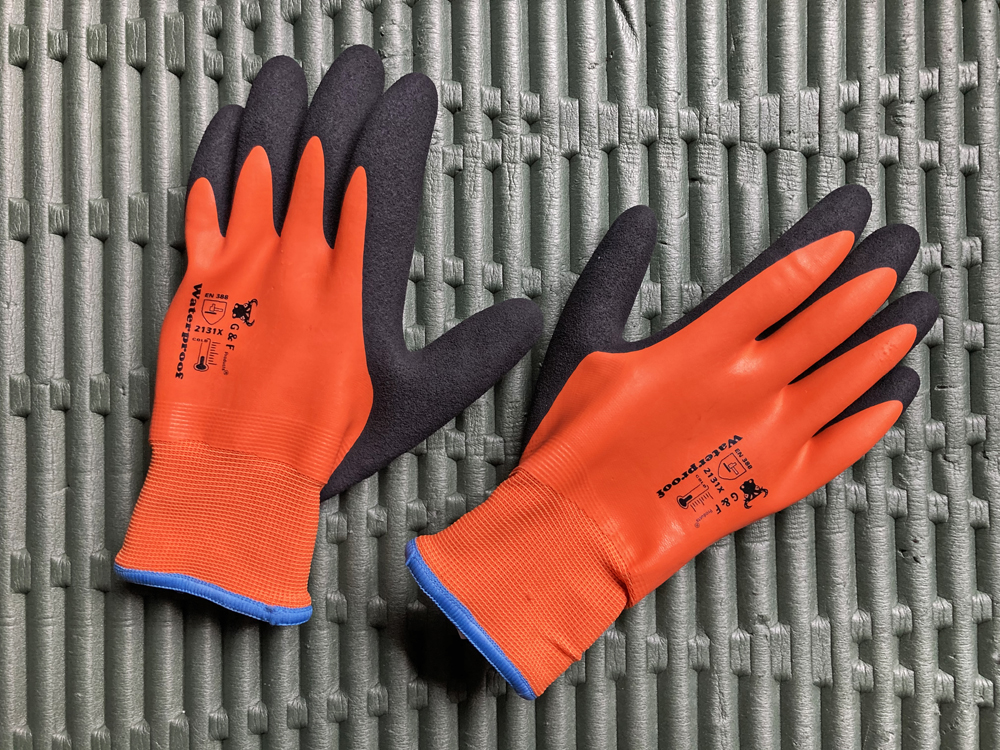
There are many types of waterproof thermal gloves, such as the Showa 282 TemRes Gloves ($16.64). Some gloves in this category use cotton materials or are very loose-fitting. Avoid the cotton ones and look for synthetic ones. I chose the “G&F Waterproof Double Thermal Winter Gloves” (4.65 oz., $11.99) because they are synthetic (no cotton) and they fit well. You’ll notice a small thermometer graphic on the gloves to indicate use for cold work conditions, rather than just gardening. The sizes run small, so I use large when I would usually use the medium. These gloves solve the wet snow issue and provide enough dexterity to set up a tent.
Mid-weight gloves
(For hiking and at camp)
In addition to liner gloves, some hikers use single-layer insulated gloves or mittens.
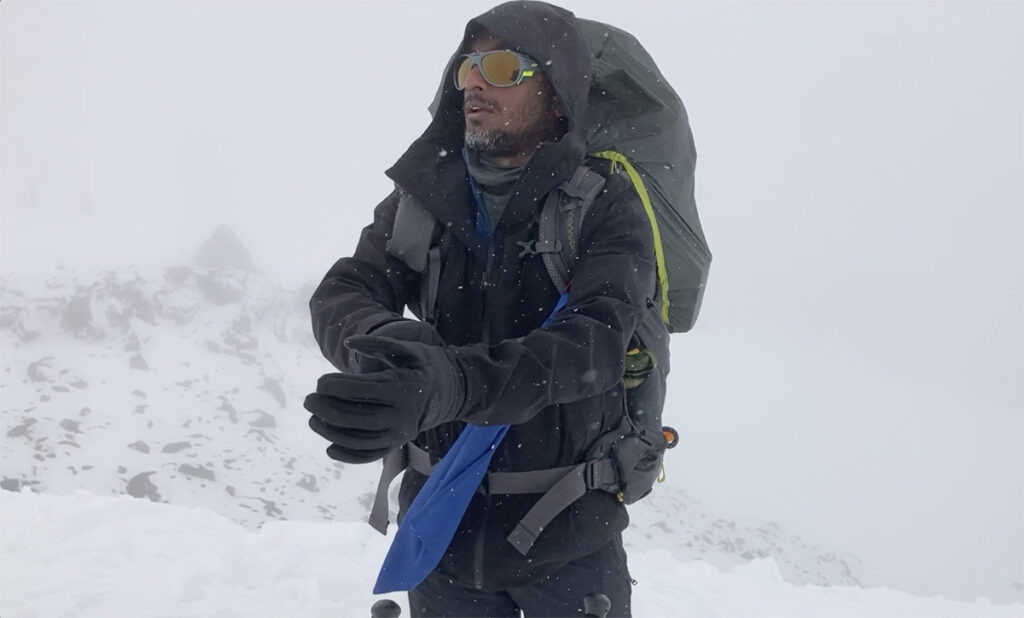
I rely on the liner gloves, waterproof gloves, or double-layered mittens instead. If you are looking for a quality mid-weight glove intended for hiking, there are many. The MEC Surprise Gloves are one of the lightest and most affordable ones I’ve seen ($39.95/6 oz).
Heavy-weight gloves and/or mittens
(For camp and hiking in windy or deep cold condition)
For windy and cold weather, I use to rely on a pair of Gordini Gore-Tex Gauntlet Snow Gloves (7.95 oz., $18.73). These offer windproof, waterproof, and breathable protection, but my fingers would still feel cold in harsh windy conditions. For that reason I switched to mittens.
Full-finger gloves are not as warm as insulated mittens. The mittens provide better circulation for your fingers and that translates to warmer hands. The argument against mittens is the loss of finger dexterity. But thick gloves, such as the Gordini’s don’t provide much dexterity either. For that reason, if you want a pair of gloves for harsh conditions, consider mittens. If you are in any doubt about which are warmer—full finger gloves or mittens, put a full finger glove on one hand and a mitten on the other and then stand around camp or do some task such as digging a cooking pit. Without a doubt, the mittens are much warmer.
I chose Outdoor Research’s Alti Gore-Tex Mitts ($199), which combine inner and outer mittens. These double-layer mitts offer good warmth with both wind and moisture protection. Even though the inner mitts fit over my liner gloves allowing three layers of warmth, I have never needed all three layers. Usually, I only need the inner mitten.
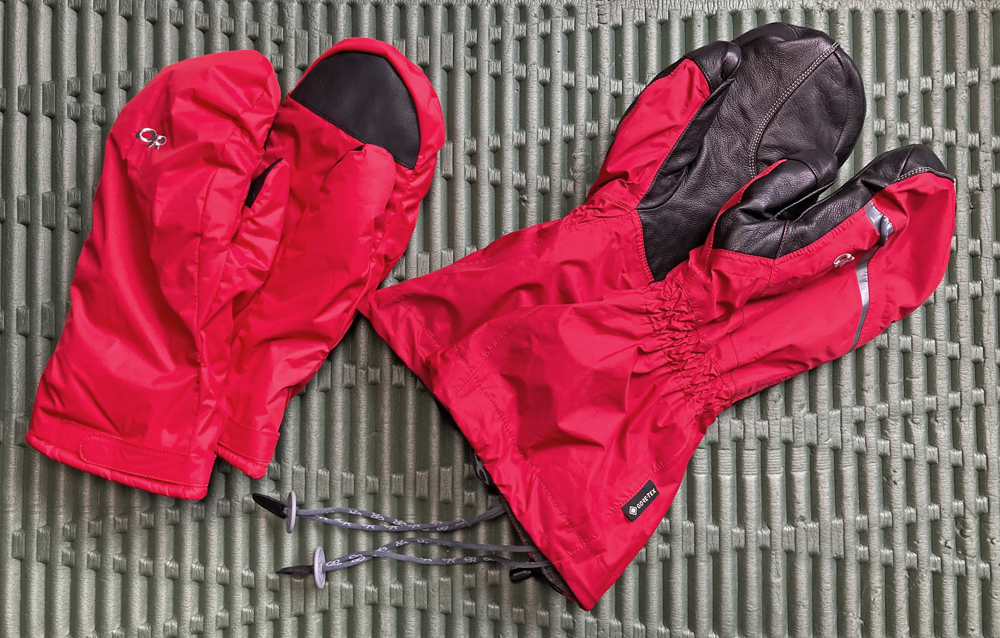
The Alti Mitts are expedition-level mittens designed for extreme conditions—“8,000-meter peaks and Arctic expeditions.” They have PrimaLoft Gold insulation which is perhaps the best type of synthetic insulation available—certainly better than down for wet conditions. This feature is why I chose them over comparable down-fill alternatives.
Generally speaking, expedition-level gear is not necessary for the Pacific Northwest at elevations between 3,000–7,500 feet (where most of our trips occur). Bear in mind that an 8,000-meter peak is 26,246 feet. The highest elevation I have camped at in Washington State is 12,000 ft (Mount Adams, near the summit). When Mount Adams is 0 degrees on the summit, lower elevations will likely be 10º F (10,000 ft) or 20º F (6500 ft).
Around camp, on most trips, I usually use thin liner gloves or just keep my hands in my the pockets of my down parka.
That said, high winds can create brutal wind-chill conditions and I don’t want cold hands in difficult situations. That’s when expedition-level mitts help you take care of your hands. I’ve seen hikers using leather climbing gloves in extreme winds and experiencing unbearable hand pain. Having the right gloves is important.
“Small errors can turn into big problems.” Always keep this saying in mind when you are winter backpacking. One such error is dropping a glove on a mountain and having it blow away, leaving your hand exposed in dangerous wind and cold. As with other gear, it needs to be secure at all times. One solution is to wear a clip or small wire-carabiner that you can clip your mittens too if you need to remove them to perform some task.
Here are some other similar expedition-level options (some of which I have seen available at much lower sale prices):
- Black Diamond offers a variety of options, the coldest rating being the Absolute Mitts (–20/–40º F, $249.95, PrimaLoft Kodenshi, 15 oz.) See also Mercury Mitts (–10/–20º F, $109.95, 9.2 oz.)
- Mountain Hardware Absolute Zero™ Down Mitt ( $200, 800-fill goose down, 11.7 oz.)
- Rab Expedition 8000 Mitten ($199.95, 850-fill goose down, 9.9 oz.). See also their Endurance Down Mittens ($135., 650-fill duck Down, 8 0z.)
- Marmot 8000 Meter Mitts ($275, 700-fill Down liner and PrimaLoft Insulated shell, 12.07 oz.)
If you are on a budget, consider laying heavily insulated gloves with lower-cost Gore-Tex mittens that can fit over them, such as REI’s Minimalist GTX Mittens ($44.95). If you prefer gloves, see Black Diamond’s Helio Three-In-One Gloves ($202, 8.2 oz.).
Convertibles
There are also fingerless mitten gloves or “convertible” gloves, meaning that you have partial fingers with the finger ends open and a mitten cover that goes over the fingers. The mitten cover can be removed when you need finger dexterity. Outdoor Research, Black Diamond, Forclaz, and others, make convertible mittens in what might be categorized as mid-weight hand protection—all very suitable for mild Pacific Northwest conditions.
I don’t use convertible gloves, but some of the hikers I know seem happy with them.
Heated Gloves
Heated gloves and other electronic devices such as action cameras and cell phones, can interfere with avalanche transceivers. You can keep cameras and phones 12 inches or more from your transceiver, but you will likely want gloves while holding the transceiver during a search. Transceivers are more likely to be disrupted by electronic devices while in search mode. Electronics create a ghost single that can confuse the direction arrows and distance readings.
I consider heated gloves to be more appropriate for ski slopes and other similar activities and not backcountry use.
Heated gloves are also less reliable than traditional insulated gloves. Depending on the gloves and settings, you can expect 2.5–6 hours of battery life.
The Multi-Glove System table
The table below shows the gloves I use for winter backpacking. The reasons and conditions are charted according to purpose, benefits, and limitations. It is rare for me to see a reason for packing all four pairs.
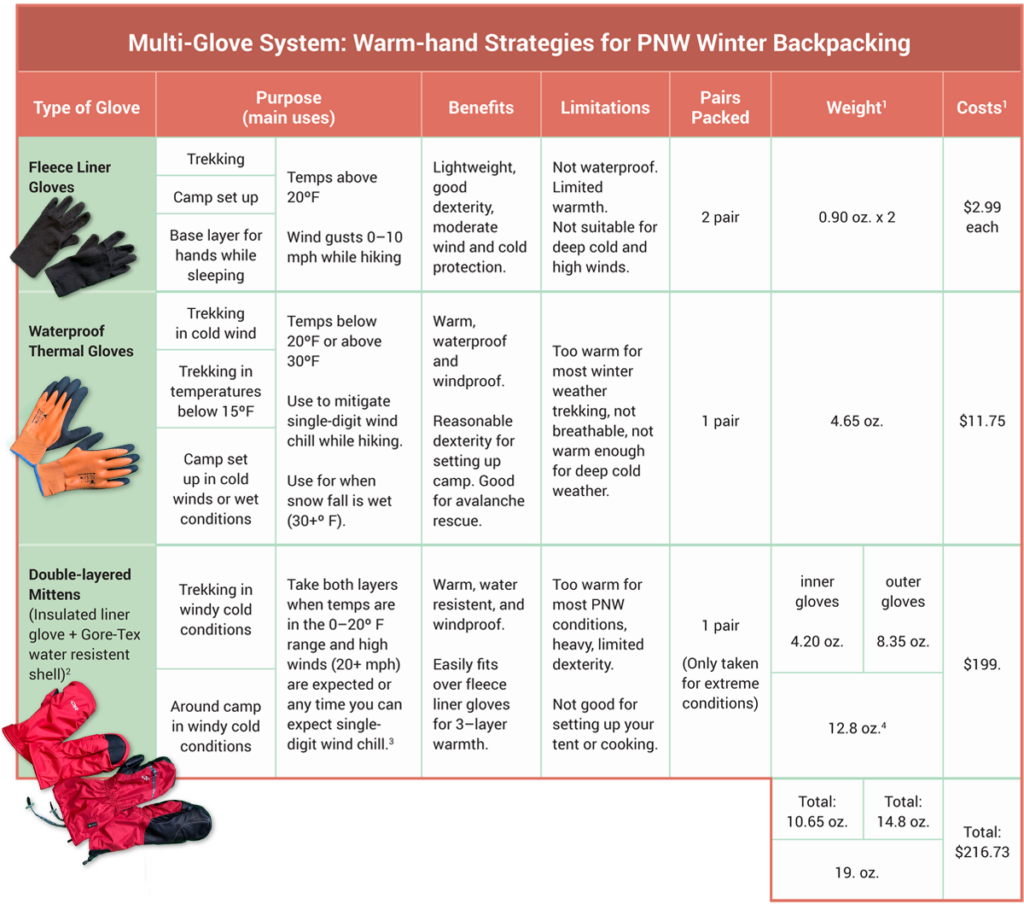
The evolution of my glove strategy
My original strategy depended on replacing wet gloves with extra gloves. This strategy had serious limitations because gloves can become wet quickly. Waterproof thermal gloves have become the solution to wet conditions. I also found that the gloves I used for winds and deep cold, the Gordini Gore-Tex Gauntlet Snow Gloves, could not keep my hands completely warm for long periods of time in the cold and windy conditions. This led me to upgrade to double-layered mittens. The old strategy worked well compared to just carrying one pair of winter gloves. The new system is much more versatile and bulletproof, but the mitts do add weight.
The old system
This strategy was okay but lacked sustained water protection and wind-chill resistance in some conditions.
- 2 fleece liner gloves + mid-weight insulated gloves (possible wet snow and moderate temperatures) or
- 2 fleece liner gloves + heavy-weight insulated gloves (possible wet snow + cold and windy conditions)
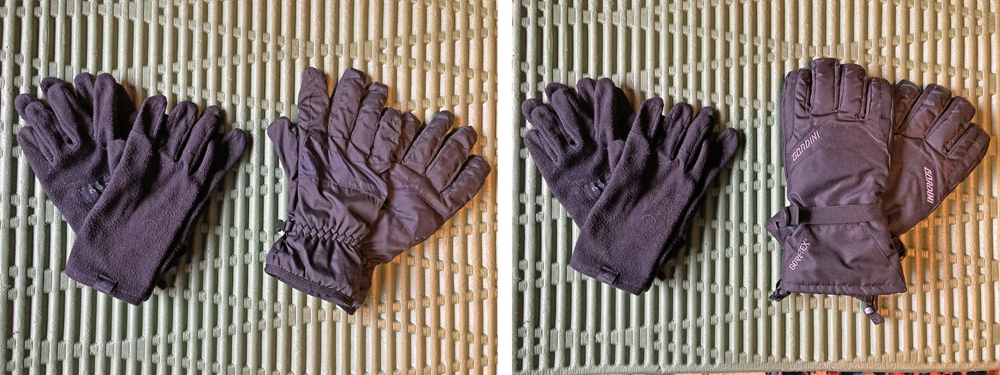
The new system
- 1–2 fleece liner gloves + waterproof thermal gloves (moderate temperatures, some wet and/or high-wind conditions) or
- 1–2 fleece liner gloves + waterproof thermal gloves + heavy-weight insulated double layer mittens (cold and high winds, with or without high winds)
I have started to rely more on the waterproof gloves and less on fleece gloves. On colder trips I don’t even bring the fleece gloves.
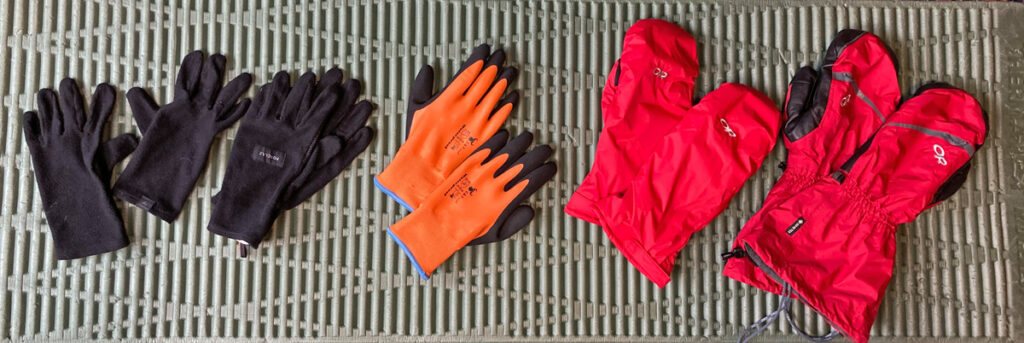
Cost
The big cost is in this strategy is the OR double-layer mitts. That said, notice that the gloves that get the most use are not expensive and will cost little to replace when necessary. The higher-priced mitts get less use and will hopefully last for many years.
In cold windy weather, I want to enjoy my time in the wilderness with no worries. I can do this with a glove system that I know will provide all the protection my hands need in the harshest conditions likely to occur.
Have any questions or thoughts. Share your comments below.
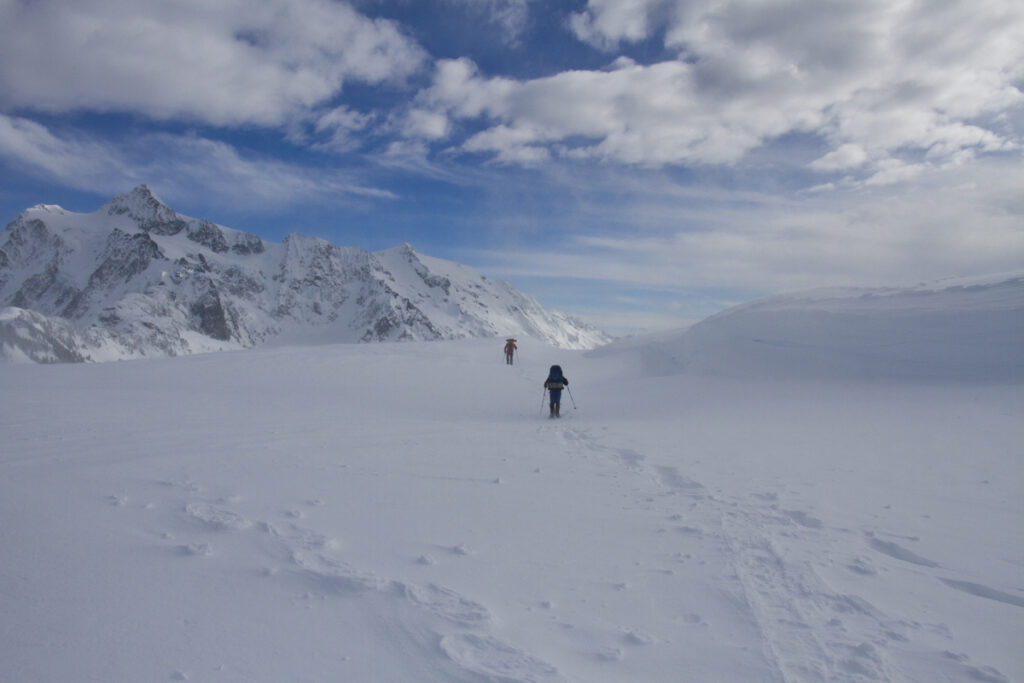
8 replies on “What are the Best Gloves for Winter Backpacking?”
Your article is spot-on. I always bring three pairs of gloves if I’m headed out on an extended trip. If it’s just one night, I’ll usually just bring one pair and live with the consequences.
I have a pair of waterproof ‘three finger’ Hestra gloves that have a removable fleece liner that I use for sub-zero or single digit temps or when I know I’ll be handling snow a lot. I have Gordini fleece gloves that I use in my tent or around camp if temps are reasonable (20-40) and I won’t be touching snow. And finally I have a pair of synthetic North Face liners (Flashdry maybe?) that I use throughout the day while I’m snowshoeing/backpacking as long as there aren’t super high winds. They’re super breathable so don’t get all sweaty or super wet if I get snow on them.
When my fleece or liner gloves do get wet, I’ll toss them in the inner pocket of my jacket in the morning or as I’m working around camp. As long they’re not soaked, they’ll either dry out or will get close to dry and warm enough that I can wear them until they do dry out completely.
With regards to three-finger gloves, I definitely recommend giving them a shot. They’re a great mix between warmth and dexterity. Since the thumb and index finger are separated from the rest of your fingers, it’s easy to wear them while setting up your tent, breaking down camp, using a stove, etc. If your hands are cold, just put your index finger in the main compartment with the rest until your fingers get warm. The pair I have also have a removable liner that I’ve worn by themselves in a pinch.
Thanks, Jake. I agree. The 3-figure Hestra gloves could be a practical and lower-cost alternative to the OR Double-layer mitts. Definitely, something to try on and consider.
Michael,
Your winter backpacking experience comes thorough the article very well. The article not only focuses on suggesting the right equipment but also shared us how we don’t have to spend heavy price to get right gloves (for certain conditions). I always struggle with cold finger tips. Your article helps new backpackers like me to find the right equipment and at decent price to enjoy the nature in winter.
I have noticed people buy gloves by warmth rating and even pick heavy weight ones (I was one of them) to make sure their hands never get cold. I learnt my lesson few times as it doesn’t work that way. Keeping the palms dry (breathability) is more important than packing all the heat that makes palms sweat a lot in heavy weight glove.
Second issue is wind. I was comfortable even with liners below freezing temperatures. But once wind hit, even my heavy duty gloves never worked. Your article shed light on it and provides multiple options to block wind and keep the warmth.
Thanks for providing valuable insight into gloves, where lot of people ignore gloves as just another accessory.
Great post, thank you! Question: do you wear liner gloves under your waterproof thermal gloves?
No. They are too tight for that. Most of the time while hiking, thin liner gloves is all that I need. The thermal gloves are good on colder days while hiking and when melting snow is an issue on warmer days and the waterproofing is handy. Anytime I need to dig a cooking pit or get my hands in the snow, I prefer the thermal gloves. Ultimately, the thermal gloves are not warm enough in temps below 25ºF if you are just standing around camp and not moving. For that, you need mittens and I do sometimes use liner gloves in my mittens, but not usually.
I took these gloves and plenty of more to Ely, MN for per week of dog sledding and ice fishing where temperatures plummeted to 25 degrees. These became my all-time favorites. They delayed alright in these conditions and performed fine even when worn alone without insulated gloves. I’ve got also used them for skiing and they have worked alright.
Well thought out and explained concept of hand layer “Strategy”. Of all the layering details one must learn winter hiking I have found my hands to be the most challenging. It has taken many hikes to learn what works and when, and not have hands both over heat and painfully cold in the same hike. As I move from day hiking to overnight I need a more focused strategy.
My hands heat up fast and sweat allot once warm. I have been out in temps <0F with bare hands on the ascent and been fine. Yet I also had an experience during an above tree line traverse, very warm close to 30F, but sustained winds above 40mph, where my warmest layer of OR shells with cheap pile fleece liners, were a bit to cold. This spooked me as I always like to have some extra reserve warmth from my warmest layers. And these conditions are quite mild for northeast summits in winter.
Some things I have learned.
Using nitrile gloves as a vapor barrier works well to contain hand sweat and keep it from spoiling the insulation in other layers. This is especially important for my OR water proof shells that can get very wet inside from sweat.
I tried the freezer gloves and found they have several outstanding attributes, in addition to the low cost. They have outstanding grip, which can really help when putting on traction and are completely waterproof. But they do not breathe at all and are extremely hard to dry out even at home once the interior wets out. Once wet inside, they get very cold. I would use them as camp gloves for modest low temps in the 20F range.
Even thin fleece gloves are too warm for me while hiking. Simple synthetic running gloves that wick moisture work for me down to ~15F. Once in the single digits, or cooling down after the ascent, I add a thin Primaloft mitten with pertex shell(Rab). These weigh nothing and pack down tinny and provide extra warmth with wind protection.
For the steep ascent and decent on rugged northeast trails you often need to use your hands on rocks and trees for safety. For these situations I prefer mid layer climbing glove with synthetic liner. The BD punishers work well for me, and I find that even if I get snow inside (oops, cuff open on outside of pack ) my body heat will dry them out and hands will be warm as long as I am moving.
For my “mittens of last resort” I recently upgrade the liners to thicker primaloft versions from BD, but still use the OR shells. They simply fit better. I find the the glove and mitten fits are all over the place with odd tight spots depending on brands and model. I have tried very hard to avoid the OR alti II’s because of their cost and just seem to warm. But have surely spent more $ and time messing with other options than likely worth it and might still do it if my latest upgrade doesn’t provide some backup warmth.
One other important detail to me, is how to store the hand layers so they are accessible while hiking. Stopping to rummage thru your pack for each layer change is just not practical. I tried many belt packs and found most are too small, they interfere with leg motion, and extra belt interferes with pack belt. I currently use a zpacks front chest pouch I like allot ( holds snacks too). I also added a firemen’s glove holder to my pack belt to hold the big mittens when I want them handy. This way I can change hand layers in the move.
Thanks Geoffrey! I appreciate hearing your experience with these options. Sweat is a big issue so different gloves for different conditions is unavoidable. The the OR alti II’s are pricy but thankfully I have gotten all the pairs I have on sale.